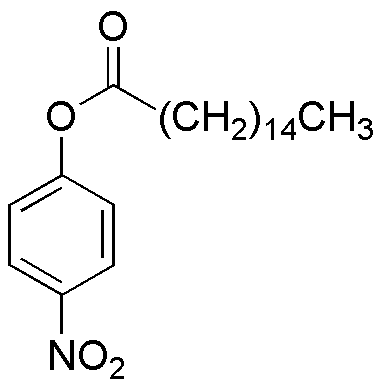4-Nitrophenyl palmitate is widely utilized in research focused on:
- Enzyme Activity Studies: This compound serves as a substrate for lipases, allowing researchers to investigate enzyme kinetics and mechanisms in biochemical processes.
- Drug Delivery Systems: Its properties make it suitable for formulating drug carriers, enhancing the bioavailability of therapeutic agents in pharmaceutical applications.
- Biodegradation Research: It is employed to study the degradation pathways of esters in environmental science, helping to assess the impact of pollutants.
- Food Industry Applications: Used as a model compound to analyze lipid digestion and absorption, providing insights into nutritional studies and food formulation.
- Analytical Chemistry: This compound is utilized in chromatography and spectrophotometry for quantifying lipids and other related compounds in various samples.
General Information
Properties
Safety and Regulations
Applications
4-Nitrophenyl palmitate is widely utilized in research focused on:
- Enzyme Activity Studies: This compound serves as a substrate for lipases, allowing researchers to investigate enzyme kinetics and mechanisms in biochemical processes.
- Drug Delivery Systems: Its properties make it suitable for formulating drug carriers, enhancing the bioavailability of therapeutic agents in pharmaceutical applications.
- Biodegradation Research: It is employed to study the degradation pathways of esters in environmental science, helping to assess the impact of pollutants.
- Food Industry Applications: Used as a model compound to analyze lipid digestion and absorption, providing insights into nutritional studies and food formulation.
- Analytical Chemistry: This compound is utilized in chromatography and spectrophotometry for quantifying lipids and other related compounds in various samples.
Documents
Safety Data Sheets (SDS)
The SDS provides comprehensive safety information on handling, storage, and disposal of the product.
Product Specification (PS)
The PS provides a comprehensive breakdown of the product’s properties, including chemical composition, physical state, purity, and storage requirements. It also details acceptable quality ranges and the product's intended applications.
Certificates of Analysis (COA)
Search for Certificates of Analysis (COA) by entering the products Lot Number. Lot and Batch Numbers can be found on a product’s label following the words ‘Lot’ or ‘Batch’.
*Catalog Number
*Lot Number
Certificates Of Origin (COO)
This COO confirms the country where the product was manufactured, and also details the materials and components used in it and whether it is derived from natural, synthetic, or other specific sources. This certificate may be required for customs, trade, and regulatory compliance.
*Catalog Number
*Lot Number
Safety Data Sheets (SDS)
The SDS provides comprehensive safety information on handling, storage, and disposal of the product.
DownloadProduct Specification (PS)
The PS provides a comprehensive breakdown of the product’s properties, including chemical composition, physical state, purity, and storage requirements. It also details acceptable quality ranges and the product's intended applications.
DownloadCertificates of Analysis (COA)
Search for Certificates of Analysis (COA) by entering the products Lot Number. Lot and Batch Numbers can be found on a product’s label following the words ‘Lot’ or ‘Batch’.
*Catalog Number
*Lot Number
Certificates Of Origin (COO)
This COO confirms the country where the product was manufactured, and also details the materials and components used in it and whether it is derived from natural, synthetic, or other specific sources. This certificate may be required for customs, trade, and regulatory compliance.


